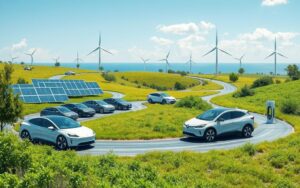The way we get around is changing, and electric cars are leading the charge. People are worried about climate change and using too much oil. Many see electric vehicles (EVs) as a cleaner option, hoping they can lower pollution and use less energy. But, there are doubts about how green they truly are. Issues like making batteries, getting the materials, and throwing them away raise concerns. This article looks closely at electric cars. It explores the good and the bad, offering a balanced view on their role in a greener future.

Introduction to Electric Vehicles
Electric vehicles (EVs) have changed the car world a lot lately. They use electric power to run, giving us an option besides gas cars. EVs include battery electric vehicles (BEVs), plug-in hybrid electric vehicles (PHEVs), and fuel cell electric vehicles (FCEVs).
Battery electric vehicles get their power from big batteries that you can charge at home or at public charging stations. Plug-in hybrid electric vehicles have both a regular engine and an electric motor. This combo lets them go farther. Fuel cell electric vehicles make electricity by mixing hydrogen and oxygen. This makes them a cool choice in the electric car world.
The good things EVs do for our planet are huge. They cut down on greenhouse gases, which makes our air cleaner. This reduction means we don’t rely on fossil fuels as much. Governments and groups are pushing for more people to use EVs. They offer tax breaks and discounts to encourage us to choose electric cars. This helps more of us switch to traveling in a way that’s better for the earth.
| Type of Electric Vehicle | Power Source | Environmental Benefits |
|---|---|---|
| Battery Electric Vehicle (BEV) | Electric battery | Zero tailpipe emissions |
| Plug-in Hybrid Electric Vehicle (PHEV) | Combination of electric and gasoline | Lower emissions compared to traditional cars |
| Fuel Cell Electric Vehicle (FCEV) | Hydrogen fuel cell | Clean energy, water vapor as exhaust |
It’s important to know the different EVs, what they do, and how they keep our planet green. As we head into a greener future, understanding these vehicles is key.
The Future of Electric Cars
The future of electric cars looks bright, with a big change expected by 2030. Companies like Tesla, Ford, and General Motors are pouring money into electric cars. This is because more people want eco-friendly travel options, and governments are helping this shift.
New battery tech will make electric cars go farther without charging. We are now seeing batteries that charge quicker and are safer. Plus, there will be more places to charge your car, making it easier to own an electric vehicle.
- Government incentives are likely to encourage electric vehicle adoption.
- Increased availability of alternative fuel sources enhances sustainability.
- Consumer demand for high-performance electric vehicles is on the rise.
The future for electric cars is looking good. Better technology and changing attitudes mean we’ll see more electric cars soon. Going electric isn’t just handy—it’s about taking care of our planet.
Current Electric Vehicle Technology
The electric vehicle scene is changing fast thanks to new tech that makes them better and more eco-friendly. A big leap forward is in the batteries they use. Most electric cars now have lithium-ion batteries. These have a lot of power and charge quickly. But there’s new battery technology on the horizon. Solid-state batteries could change the game with their higher efficiency and longer life.
More places to charge electric cars have helped more people choose them. Both public and private charging spots are growing in number. This makes it easier for electric car owners. Fast-charging stations are especially important. They let drivers charge up much quicker than before.
Here are some important numbers to know:
| Battery Type | Energy Density (Wh/kg) | Charging Time (hours) | Lifespan (cycles) |
|---|---|---|---|
| Lithium-Ion | 150-250 | 1-8 | 500-1500 |
| Solid-State | 300-500 | 0.5-3 | 1000-5000 |
To wrap it up, advances in electric vehicle technology make the market more efficient and user-friendly. These innovations are not just good for the planet. They also help us look forward to a future where sustainable transport is the norm.
Sustainable Transportation and Its Importance
Sustainable transportation is key to fighting global climate change. Switching from traditional vehicles to electric ones cuts down on carbon emissions. Electric vehicles (EVs) don’t release pollutants from exhaust, making them better for the planet.
The environmental impact of transportation is huge. In many cities, it causes a lot of greenhouse gas emissions. Moving to sustainable transportation can reduce these emissions. Plus, it leads to cleaner air and better health for everyone. Using public transit, biking, and walking more helps in this effort.
Supporting green energy vehicles is more than a personal choice. It’s about changing society to encourage eco-friendly infrastructure. Cities are adding electric cars, better public transit, and nicer bike paths to lessen their environmental impact.
Here are key benefits of sustainable transportation:
- Reduction of greenhouse gas emissions
- Improved public health outcomes
- Enhanced energy efficiency
- Cost savings for consumers and governments
- Support for local economies through green job creation
For sustainable transportation to work, everyone must work together. That includes governments, car makers, and people. We need to use many types of transit. It’s also important to keep improving electric vehicles and public transportation.
| Transportation Type | Carbon Footprint (g CO2/km) | Environmental Impact |
|---|---|---|
| Gasoline Vehicle | 120 | High emissions; significant air pollution |
| Diesel Vehicle | 130 | Higher NOx emissions; health risks |
| Electric Vehicle | 0 | No tailpipe emissions; lower overall impact |
| Public Transportation | 50 | Efficient use of space; reduced emissions |
| Bicycle | 0 | No emissions; promotes health and fitness |
Switching to sustainable transportation isn’t just a passing trend. It’s a vital step to effectively fight climate change. By choosing electric vehicles and sustainable transit, we move towards a greener future.
Electric Car Innovations Shaping the Future
Electric car innovations are leading the change in how we see transportation. The future of electric cars relies on new technologies. These aim to improve performance and the user experience.
Autonomous driving is a key development. Companies like Tesla and Waymo are working hard in this space. They want to make electric vehicles that drive themselves safely. This could lower accident rates and make traffic flow better, changing our cities.
Vehicle-to-grid (V2G) systems are another big step forward. These let electric cars give energy back to the power grid at busy times. Power companies see the value of V2G in managing energy better. This marks a key moment for electric vehicles (EVs).
Artificial intelligence (AI) is also making EVs smarter. It adds features like predictive maintenance and personalized driving. These innovations are changing how we travel every day.

Smart mobility solutions are also on the rise. Their goal is to make city transport smoother and less crowded. By combining public transport with electric cars, cities can become greener and more efficient.
| Innovation | Description | Impact |
|---|---|---|
| Autonomous Driving | Self-driving technology aiming for safer transport. | Reduces accidents and optimizes traffic. |
| Vehicle-to-Grid (V2G) | Allows cars to send energy back to the grid. | Supports energy management and sustainability. |
| AI Integration | Smart features to enhance vehicle functionality. | Improves user experience and vehicle efficiency. |
| Smart Mobility Solutions | Linking electric vehicles with public transport. | Reduces urban congestion and enhances travel efficiency. |
The landscape of electric vehicles is quickly evolving with these innovations. With a commitment to sustainability and tech, electric cars have a bright future.
Electric Vehicle Industry Trends
The electric vehicle (EV) industry is growing fast, thanks to more people wanting sustainable options. Many are choosing EVs to help the environment. These cars are not only better for the planet but also perform well.
Sales of electric vehicles are increasing. This surge is because of their better fuel economy and lower upkeep costs. Automotive brands are also focusing on being more eco-friendly. They’re making EVs easier to buy and more appealing.
“The automotive market is witnessing a turning point, as consumers increasingly opt for electric over traditional vehicles.”
There’s a wider range of EVs now. Car makers are offering more electric models to meet people’s needs. With government incentives and better batteries, EVs are set to grow even more.
To wrap up, the EV industry is evolving due to new technology and a shift in what consumers want. Companies that adopt electric mobility will likely succeed in this new market.
Electric Vehicle Market Outlook
The electric vehicle market is looking up. Projections show a big increase in electric vehicle (EV) use in the next ten years. Analysts think global EV sales might top 30 million by 2030. This is thanks to many factors that are changing the electric car scene.
Governments are key in this growth. They offer tax breaks, subsidies, and more to make people pick green cars. Companies like Tesla, Ford, and GM have big plans for electric cars too.
Technology is also helping. Better batteries and more charging spots make EVs cheaper. This makes people more interested in electric cars.
Big names in the market now include traditional car makers and tech firms like Google and Apple. The competition is fierce, with new startups taking on the big car companies.
| Year | Global EV Sales (in million units) | Market Share (%) |
|---|---|---|
| 2021 | 6.7 | 9.3 |
| 2022 | 10.5 | 13.5 |
| 2023 | 13.8 | 18.2 |
| 2025 | 20.0 | 25.0 |
| 2030 | 30.0 | 35.0 |
To sum up, the future of electric cars is bright. Support from governments, industry changes, and tech advances drive this. Together, they’re making green cars a big part of our transport future.
The Electrification of Transportation
The electrification of transportation is changing how we move around the world. Electric vehicles (EVs) are more than new tech. They are the start of a move to sustainable transportation. Cities are now planning for EVs in their public transit, making areas friendlier for walking and biking. This shift helps cut down air pollution, make traffic better, and improve our living quality.
There’s a global push for electric mobility. Governments are helping people buy EVs with tax cuts, rebates, and building the needed infrastructure. Businesses, governments, and people are working together. This teamwork is key in setting up charging spots everywhere, making EVs an option for more people.
New rules are helping this change too. Cities are fighting pollution and getting more EVs on the road through new laws. Some cities have zones where only low-emission vehicles can go. This encourages people to choose electric cars. With these rules, we get closer to cleaner air and better cities.
| Initiative | Purpose | Impact |
|---|---|---|
| City Regulations | Implement low-emission zones | Reduced traffic emissions |
| Incentive Programs | Provide tax credits for EV purchases | Increased adoption of EVs |
| Public-Private Partnerships | Develop charging infrastructure | Enhanced accessibility to EVs |
The effort to electrify transportation is building a green future for our cities. As we want more eco-friendly ways to travel, working together is essential. Cities, businesses, and communities must keep collaborating for a clean, efficient transport system.
Green Mobility Solutions for the Future
Green mobility solutions are changing the way we think about transportation. They make travel systems, both more efficient and friendlier to the environment. By using different transportation modes, cities become better for everyone.
Shared mobility is making waves in sustainable transport. It lets people use cars when they need them without owning one. Services like Zipcar and Turo let people drive electric cars and reduce pollution. Carpooling also plays a big part by making trips more efficient and lowering traffic.
E-scooters and bikes are vital for short urban trips. They help reduce the constant use of cars. By adding these to city transport options, it makes it easier for everyone to choose greener ways to get around.
Combining electric cars with public buses makes city transport even cleaner. It helps cities cut down on pollution and fight climate change. Including electric buses and bike-share programs makes the community better connected and the air cleaner.
Conclusion
Looking ahead, electric cars are key to sustainable transportation. Advances in this technology have brought us better efficiency and eco-friendly options. Companies like Tesla, Ford, and Volkswagen are leading the charge, changing the game rapidly.
Innovations in battery tech and charging are changing electric cars. Everyone, from governments to car buyers, must support electric mobility. It’s essential for a greener future. Together, we can overcome hurdles and make the most of these advancements.
The future of electric cars goes beyond tech or money. It’s about changing how we live and move in harmony with nature. By choosing eco-friendly transport, we’re shaping a better world for all of us.
FAQ
What are the main benefits of electric cars?
Electric cars offer several advantages. They reduce greenhouse gas emissions and have lower operating costs. They are more energy-efficient than traditional vehicles. This helps in creating sustainable transportation by using green energy and cutting down fossil fuel use.
How does electric vehicle technology work?
Electric vehicles (EVs) run on electric motors and rechargeable batteries. There are three main types: Battery Electric Vehicles (BEVs), Plug-in Hybrid Electric Vehicles (PHEVs), and Fuel Cell Electric Vehicles (FCEVs). This technology delivers a quieter ride and instant torque for a smooth drive.
What advancements are being made in electric vehicle technology?
We’re seeing big improvements in battery tech like lithium-ion and solid-state batteries. These enhance how much energy they can store and how quickly they can be charged. Also, there are more super-fast chargers and broad charging networks now. This helps more people choose electric cars.
What is the future outlook for the electric vehicle market?
The future looks bright for electric vehicles (EVs). Sales are expected to soar in the coming decade. This growth is fueled by higher demand from consumers, government incentives, and carmakers investing in electric tech. It’s a major move towards more sustainable transportation.
How do electric cars contribute to sustainable transportation?
Electric cars are key to eco-friendly transportation. They cut down carbon footprints and reduce air pollution. By using renewable energy for charging, they support global environmental goals. This shift to electric cars is part of a bigger push for greener transportation solutions.
What challenges do electric cars face in terms of sustainability?
Electric cars face some tough challenges. The environmental impact of making batteries and extracting lithium is concerning. So is finding sustainable ways to dispose of and recycle these materials. We need to solve these problems to secure a sustainable future for electric vehicles.
How are governments supporting electric vehicle adoption?
Governments are helping people switch to electric vehicles through incentives like tax breaks, rebates, and grants. They’re also investing in better charging stations and promoting laws that favor electric cars. These efforts are speeding up the shift to eco-friendly transportation.
What innovations are shaping the future of electric cars?
New tech like self-driving systems, vehicle-to-grid (V2G) setups, and AI are changing electric cars for the better. These features make driving more enjoyable, use energy smarter, and increase efficiency. They’re transforming how we get around in cities.
What role will the electrification of transportation play in urban planning?
Electrifying transportation will reshape urban planning. It will lead to smarter infrastructure and better traffic management. Electric mobility will become a bigger part of public transport. This will improve life in cities and help meet sustainability goals.




